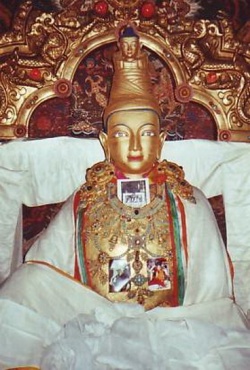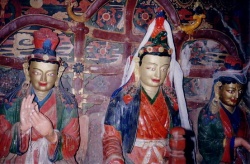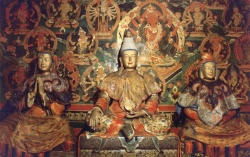Dharma from the sky I: Legends and history
We ‘modern’ historians are inclined to place much of the material that makes up traditional Tibetan histories into the category of legend. We might want to explore the possibility that actual historical occurrences may lie behind the legends.
On the other hand we may want to argue that the legends should be treated as valid in their own right, as part of the construction of Tibetan historical identity (perhaps in this case we might think of ourselves as ‘post-modern’ historians).
Rather than pursuing that particular argument here, I want to suggest that ‘traditional’ Tibetan historians did not themselves accept all of the legendary material that was handed down to them in their own historical tradition.
Indeed the debate about how appropriate it might be to apply the principles of rational thought to these legends existed in Tibet for centuries.
A case in point is the story of the first appearance of Buddhism in Tibet, a story that goes back at least as far as the Pillar Testament (i.e. 11th-12th centuries).
The story is that a casket containing Buddhist books fell from the sky and landed on the roof of the Tibetan royal palace.
This was during the reign of King Lhatotori, who is said to have ruled five generations before the first historically dated Tibetan king, Songtsen Gampo, which would take us back to the fifth century (though the traditional histories date him much earlier).
Neither the king nor anyone else in Tibet was able to read these heaven-sent texts.
The king resealed the casket and gave it a name, the Secret Potency (gnyan po gsang ba).
The casket then remained untouched in the palace until it was reopened by Songtsen Gampo, so that the texts could be translated.
Now, there was an argument between Tibetan historians about whether this story of the books falling from the sky was a historical fact.
The opinion that it was not was put forth by the 13th-century Tibetan scholar Nelpa Paṇḍita.
He argued that the books, rather than falling from he sky, were brought to Tibet by an Indian scholar and a Khotanese translator.
According to Nelpa Paṇḍita, when the two men presented the King Lhatotori with the books, they discovered that he could neither read them nor understand their meaning. Realizing the futility of their mission, they returned to from whence they came.
Nelpa Paṇḍita suggests that the story about the casket falling from the skies was simply made up by the Bönpos (the pre-Buddhist religious of Tibet) based on their reverence for the sky.
Although this alternative account never replaced the story of the books falling from the sky, many later Tibetan histories gave both versions.
However, the Fifth Dalai Lama, for one, clearly felt that the original version of the story ought to be defended.
In his 17th-century work Song of the Spring Queen he launched a highly personal criticism against ]]Nelpa Paṇḍita]], and defended the original legend:
Nelpa Paṇḍita’s belief that it is absurd for a casket to fall from the sky is proof of his stupidity. In the auspicious circumstances in which the teachings were first discovered, the magical activities and compassion of noble individuals go beyond thought.
It is interesting to see that the Great Fifth (as he was often known) specifically defends the irrationality of the story. What is at stake is clearly whether one should depend primarily on rational thought” (Tib. bsam) in assessing historical accounts, in particular those accounts which treat of the foundations of Tibetan Buddhism.
From the point of view of rational thought, Nelpa Paṇḍita’s version of the story is quite credible.
If the kingdoms of Central Tibet did have any contact with Buddhism and Buddhist texts before the expansions of the 7th century, it would have been through the agency of individuals making the journey to Tibet from neighbouring Buddhist regions.
Some of these individuals, whether merchants or missionaries, may have brought books with them.
This is the opinion of the 20th-century Tibetan historian W.D. Shakabpa, who in his Tibet: A Political History favours Nelpa Paṇḍita’s version of the story.
In his opinion, the king told his ministers that the books had fallen from the sky because he didn’t want them to know that they had come from India.
In any case, I think this shows that the debate about the role of rationality in assessing historical facts is very much a part of the Tibetan historical tradition.
It’s also clear that the historian who wonders what real occurrences might lie behind historical legend is not a creature found only in our ‘modern’ historiography.
References
Shakabpa, Tsepon W.D. 1967. Tibet: A Political History. New Haven: Yale University Press. [pp.24-25]
Tibetan sources
1. Bka’ chems ka khol ma [The Pillar Testament]. Kan su’i mi rigs dpe skrun khang. 1989. [p.91]
2. Ngag dbang blo bzang rgya mtsho (The Fifth Dalai Lama). Dpyid kyi rgyal mo’i glu dbyangs [[Song of the Spring Queen). Available as THDL e-text. [section 3.2]
3. Nel pa paṇḍita / Helga Uebach. Nel-pa Paṇḍita’s Chronik Me-tog Phreṅ-wa: Handschrift der Liberary of Tibetan Works and Archives, Tibetischer Text in Faksimile, Transkription und Übersetzung. Munich: Kommission für Zentralasiatische Studien, Bayerische Akademie der Wissenschaften, 1987. [folios 7a4–7b3]


